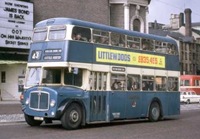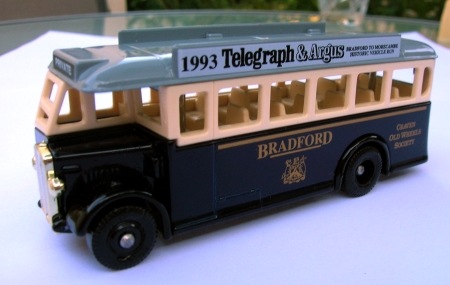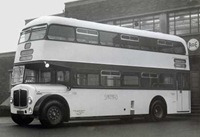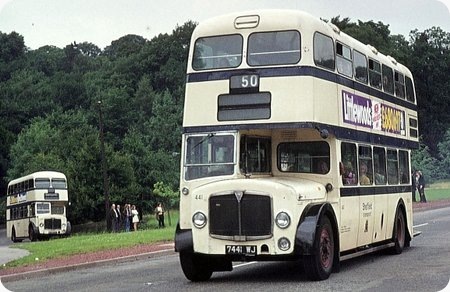Bradford Corporation – AEC Regent V – 6208 KW – 208
Bradford Corporation
1964
AEC Regent V 2D3RA
Metro Cammell H40/30F
A while ago there was a thread re Bradfords Regent Vs so I thought I would contribute one of my shots it is of 208 a 2D3RA type with clutch and four speed synchromesh gearbox, and MCW H40/30F bodywork. When I worked in the Traffic Office for Halifax Passenger Transport in the mid 1960s, I used to ride from time to time on Bradford buses between Queensbury and the city centre. The howl of the conventional transmission Regent V in the intermediate gears on hills was part of the soundtrack of life in that part of West Yorkshire in those days – Hebble and Halifax also had buses of this type. In theory, the blue/cream livery should have been quite attractive, but in practice Bradford’s buses always had a slightly disappointing appearance to me. It was often said back then that blue paint did not wear as well as red or green, and this seemed to be borne out by the matt finish that Bradford’s buses seemed to acquire very quickly. Perhaps the Corporation’s bus washing equipment had a deleterious effect upon the paintwork.
Photograph and Copy contributed by Roger Cox
A full list of Regent V codes can be seen here.
29/09/11 – 09:02
I was once with a company whose corporate colour was light blue. It was not a very stable colour & depended too for its appearance very much on what colour was underneath it.
Joe
30/09/11 – 12:23
Bradford`s blue was always subject to quick fading, and the problem seemed to worsen when the Humpidge livery eliminated cream bands, grey roofs, and yellow lining. There was no finer sight than a newly repainted Bradford bus, but, alas, after a week, the same old look of faded gentility would appear!
Perhaps BCPT should have resisted the temptation of using the Southend blue which so inspired them in 1942 when 4 trolleybuses from that town appeared on loan. The original dark blue was quite sombre, but had a certain elegance which seemed to emphasise the no nonsense attitude of a busy industrial city.
I cannot imagine what the MkVs would have looked like though!
John Whitaker
30/09/11 – 15:22
I think the overall effect would be akin to the Lytham & St Annes blue or perhaps Pontypridd UDC both of these used a dark blue as their main colour.
Chris Hough
30/09/11 – 16:28
Hi Chris.
No, I knew the Lytham fleet well, Bradford`s pre war blue was VERY dark, almost like EYMS. Lytham blue was more a royal blue, whereas Bradford’s was classed as ultramarine. Check it out on preserved tram 104.
John Whitaker
Just so happen to have a model AEC Regal in Bradfords old Livery.
Peter
30/09/11 – 21:59
To change the subject from paint to move to that transmission howl. Being brought up in Rochdale in the 1950’s I was obviously a great admirer of AEC Regent V’s. In the early 1960’s I made a journey to Huddersfield to look at the trolleys and after taking the Hebble 28 to Halifax over Blackstone Edge I changed to a 43 for Huddersfield. It was a Halifax LJX Regent V. I was absolutely distraught at the howling and whining sounds made by the bus especially on the long climb up to Ainley Top from Elland. Our Regent V’s in Rochdale never made sounds like that. Of course I found out later as my knowledge of bus engineering expanded that the Rochdale vehicles had fluid transmission, either pre-selectors (NDK batch) or Monocontrol on the later ODK, RDK and TDK registered vehicles. The NDK batch also had Gardner 6LW engines. I was never such a fan of the more common synchromesh Regent V’s after that experience.
Philip Halstead
12/11/11 – 06:11
Ah! The Bradford Regent Vs. They appeared to fall into two distinct camps – people either loved them or loathed them, and I make no apologies for nailing my colours to the loved ’em mast every time! As a youngster I used to try and guess which batch an approaching Regent V was from, before the number plate became visible. If memory serves correctly, taking the first batch (the PKYs) as a yardstick, these had fixed glazing in the front upper deck windows with a ventilator in the roof dome above them. The UKYs were broadly similar but whereas the PKYs had a straight lower front edge to the front wings, the UKYs (and subsequent batches) had a somewhat racier rounded lower front edge to them. Then came the YAKs, similar to the UKYs, but with opening front ventilators in the front upper deck windows and no ventilator in the front dome. The most noticeable change came with the YKWs, as they were the first to sport St Helen’s-style destination displays showing ultimate, via and route number information boldly and clearly (a classic display if ever there was one). They also had single rather than two-piece windscreens, fuller roof domes and a subtly deeper area of cream above the lower deck windows and cab/canopy. They lacked front dome ventilators but retained the opening vents in the front upper deck windows. Then came the 2xxx KW batch, seemingly identical to the YKWs, but the eagle-eyed would spot that the roof dome ventilator was back! The final batch – the 6xxx KWs – were the ones that I had to admit defeat on as they looked every inch the same as the 2xxx’s. However, once aboard, you immediately knew which was which as the 6xxx buses had light blue internal window surrounds rather than the cream used hitherto. In later years the Transport Department converted the PKYs, UKYs and YAKs to the St Helen’s-style destination displays, but they were still readily identifiable as they retained the original smaller route number blinds and tracks. Later they also added roof dome ventilators to the YKWs too, bringing them into line with the two batches of KWs. Fond memories of buses with undeniable character.
Brendan Smith
06/07/13 – 07:00
Has has been said many times the Bradford livery was superb when ex works. I can remember the FKY batch of Regent IIIs were always immaculate when returned from two year recertification. FKY 7, which was probably the last to gain a five year certificate, could always be easily identified at a distance by the creamy brown window pans caused by rust coming through, and the faded blue livery, until its later recertification, which transformed it from the ugly duckling to a magnificent machine in line with its sisters.
David Hudson
06/07/13 – 09:18
I have always been quite distressed by the vicious condemnation from many quarters of the Bradford Mark Vs. The exaggerated accounts of rough and violent rides are wicked to hear, and any such discomfort must surely have arisen largely from careless or deliberate bad driving. I drove many Mark Vs in my time, both two pedal and live gearbox, and never had any trouble with them. I was even allowed, for a reason I can’t remember, to drive a full load of folks around the Sandtoft circuit in preserved M & D VKR 37 – at the time I’d obviously never seen that vehicle previously, nor had I driven any Mark V for many years, but it gave no problems at all. Possibly the mountainous roads in Bradford encouraged "forceful" driving but, if so, there’s no excuse for this. Certainly the superb pure howling of the Mark V manual transmission in the first three ratios was glorious to hear, as indeed was the "petrol engine" smooth quietness in top !! I’ll never forget the civilised magic of the Ledgard Roe sextet 1949 – 1954 U when they appeared in September 1957. Incredibly, despite the use of the green demonstrator 88 CMV, they were not expected by the staff in general – surely one of the best kept secrets ever, especially within a relatively small operator.
Chris Youhill
07/07/13 – 07:36
Well said, Chris. Despite having the (slightly) suspect wet-liner AV590, Sheffield’s 2D3RA and 2D2RA Regent Vs gave full value and service lives in the mountains of Sheffield and the Peak District. […..and the "Pre-war Howl" of the 2D3RA was part of their (musical) attraction.]
David Oldfield
 Vehicle reminder shot for this posting
Vehicle reminder shot for this posting
14/07/13 – 07:50
Chris, I heartily endorse your defence of the much maligned Bradford AEC Regent Vs. Having had the pleasure of riding on many of the ‘YKWs’ and ‘KWs’ over the years, I feel much of the ‘problem’ as you rightly say was down to very poor driving. Whether they had lower ratio rear axles to cope better with Bradford’s many hills I do not know, but this would give improved acceleration on the flat, such as the services along Manningham Lane to Saltaire, Bingley and Crossflatts. Also if the engines were fully rated, this combination would no doubt encourage ‘spirited’ performances from BCT’s small band of would-be rally drivers. Exhaust brakes were also fitted to the buses, giving increased deceleration on braking if needed, so in the hands of said rally drivers – well you can imagine passenger comments! (Not to mention those of the poor conductor saddled for a full shift).
Having also ridden on East Yorkshire Bridgemasters and Renowns, which shared many mechanical components with the Regent Vs, these did not appear to have the same afflictions. They generally seemed to be treated with much more respect by their drivers, and the ride was all the better for it. Another benefit of a more relaxed driving style with the AECs was that passengers were treated to the wonderful musical tones of the gearbox, as mentioned by Chris Y and David O, for that much longer!
Brendan Smith
14/07/13 – 10:04
Thank you indeed Brendan and David for your supporting views, and I’m sure that if a survey had ever been carried out amongst thinking folks as to the popularity of the Mark Vs the "Ayes would have had it." We all have regrets on the lines of "Oh, if only I’d had my camera" and just such an occasion for me and a friend was when we foolishly omitted to take ours to Saltaire on the last evening of trolleybus operation. The trolleybuses had left that morning to take up service and were never to return to Saltaire Depot. In that quiet Saturday mid evening the front yard was full of new Mark V AEC Regents, and someone had taken the trouble to set all the route numbers to "O I L" – rather a nice touch really. So, to the lay passengers, its perhaps understandable to a degree that the complete difference in the nature of their future riding experience came as a culture shock, especially as I suppose only a minority were gifted as devotees of classical auto-mechanical music !!
Chris Youhill
14/07/13 – 14:21
My first contribution to this site quite a while back now was in defence of the much maligned Bradford Mk.V’s – and Mk.V’s in general – and I remember being heartened by Chris Youhill’s brilliantly worded response, as I then realised I wasn’t the only person on the planet who appreciated their qualities and characteristics.
At the risk of covering old ground, Regent V’s were most certainly not Southall’s most durable and troublefree model, nor the most refined – that accolade in my opinion belongs with their 9.6 preselector Mk.III. I admit that Bristol, Guy and Daimler probably all turned out far more rugged, reliable, and economical products.
There were so many different variants on the Mk.V theme. Permutations of short ones, long ones, lightweight and heavyweight, AV470/590/690/691’s, ones with the old 9.6, synchromesh or Monocontrol, tin front or conventional – they were all fascinatingly different, with widely varying characters and levels of durability and performance.
Even apparently similar ones could perform quite differently. At Halifax we had sixteen of our ‘own’ and a small number of ex-Hebble ones. Though all were 30ft. AV590/Synchromesh types I believe ‘ours’ had in-line fuel pumps, whereas the Hebble ones had rotary pumps and performed quite differently – much better actually. Some could even be a bit dull – I always thought that Yorkshire Woollen’s Metro-Cammell-bodied ones were rather lacking in something.
Then in PTE days we received quite a few ex-Bradford ones either on loan or transferred. These were a revelation, infinitely better than any of ours, and from my own purely personal enthusiast/driver/non-engineering point of view were the most satisfyingly pleasurable buses that I have ever driven during my 40 year career.
Absolutely loved ’em !
John Stringer
15/07/13 – 08:27
36 hours ago I was enjoying working on Leigh Renown 28.
A journey from West Yorkshire to the East Coast and back for tea! Fantastic gearbox music and a booming exhaust.
I am a Bradford lad and loved the Mark Vs.
Geoff S
15/07/13 – 08:28
Just because one holds a less than rhapsodic view of a particular piece of machinery, that does not automatically brand one as an insensitive or clumsy driver. My driving experience of the Regent V was limited to the Halifax examples, and I make no apology for stating that I found them crude and unpleasant machines. On the plus side, they were quite lively, the steering was pleasantly light, and the all synchromesh gearbox was extremely easy to use. However, the clutch was excessively light and vague in operation, so that, unlike the much heavier but predictable Leyland clutch, one could never be exactly sure when transmission engagement would occur. Many drivers got round this by slipping the clutch in at (to my mind) excessive revs, which, in turn, gave rise to a juddery take off from rest, but I would endeavour to take greater care (yes, even though I was not the greatest fan of the Regent V). The ear splitting gearbox howl in the indirect ratios, which were perpetually required on the Halifax hills, plus the indescribable racket from the accelerator pedal as it rattled freely when released under braking or when descending hills, made the Regent V the noisiest bus, by a huge margin, that I have ever driven (though the Seddon Pennine IV is close behind). The accelerator pedal had an incredibly light return spring, so that holding the pedal at an intermediate position for driving at modest speeds left one with an aching ankle, and the air brakes had a totally non progressive feel to them. A gradual depression of the pedal produced no effect at all until suddenly over application came about. Easing off again then produced no result until, with a whoosh of escaping air, the brakes released entirely. This was a feature of AEC air brakes on other contemporary bus models, such as the Reliance. How Southall lost the knack of designing smooth progressive brakes after the excellent Regal III/Regent III, puzzles me to this day. John Stringer’s comment re in line v distributor fuel pumps is interesting, as it is generally held that the in line pump is more tolerant of variable fuel quality. I suspect the the distributor pumps on the Hebble buses were set rather more generously.
We all have our own favourites and bête noires, and such views should surely be respected. I certainly refute the implication that my opinion of the Regent V arises from a shortfall in competence.
Roger Cox
15/07/13 – 10:25
I think the gentleman protesteth too much. I may have missed something, but I cannot recollect anyone accusing Roger of incompetence.
David Oldfield
15/07/13 – 10:26
As far as I can see, nobody has implied that at all Roger.
John Stringer
Quick links to the - Comments Page - Contact Page - Home Page





